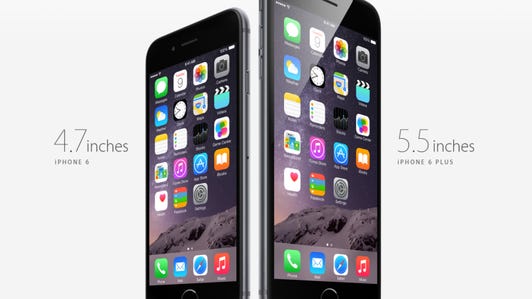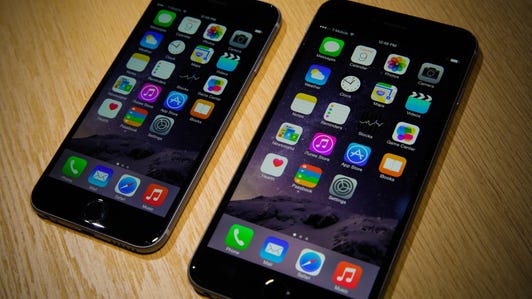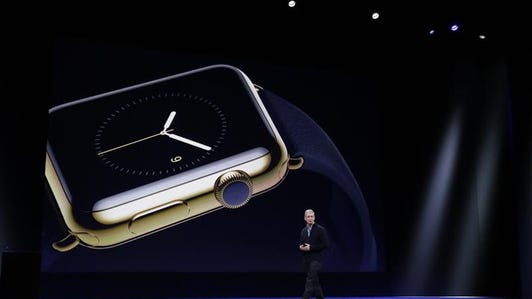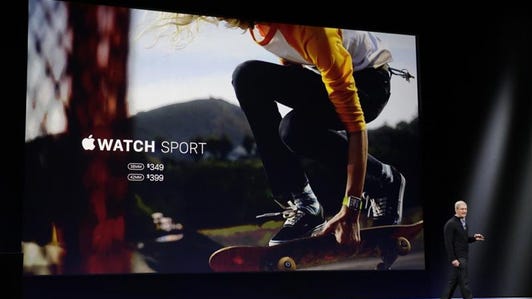
James Martin/CNET
When Apple CEO Tim Cook introduced his company’s first wearable device during a flashy event on Tuesday, one of the biggest surprises was its name.
Most people expected Apple to show off an “iWatch” and an “iPay” or “iWallet” mobile payments system to go along with it. But Cook didn’t stick to the “i” moniker at all, shirking the branding that has been pervasive at the company since the iMac computer landed in 1998.
His device was “Apple Watch,” a gadget he called a “breakthrough” product that works as a health and fitness device, a walkie-talkie, an Apple TV remote control, and a notification device, among other things. Cook also introduced Apple Pay, a new system that allows users to buy items by tapping their iPhones to sales terminals and by using their fingerprint for quick online purchases.
The Apple Watch “is the next chapter in Apple’s history,” Cook said Tuesday to the audience of more than 2,000 people. “The foundation of Apple is built on the best computers in the world with the Macintosh, the best tablets in the world with iPad, the best phones in the world with iPhone, and it was made even better today.”
But why the name change?
See also
- With its debut smartwatch, Apple aims to make wearables fashionable
- With new smartwatch, Apple buys itself some time
- CNET’s first thoughts on the Apple Watch
- iPhone 6, iPhone 6 Plus, Apple Pay, and the Apple Watch: Here’s everything Apple just announced
Apple’s not saying, but some analysts believe the Apple Watch and Apple Pay represent the Cupertino, Calif., company’s efforts to start a new era — one separate from Steve Jobs. Jobs, who died from pancreatic cancer in October 2011, had his hand in every product Apple introduced after he returned to run the company in 1997. Each iPhone and iPad released since his death built on the first devices he created, rather than something entirely new. But the Apple Watch is different.
Leading into Tuesday’s event, hopes were high that Cook would finally take Apple into new territory. Until now, Cook, who took over as CEO two months before Jobs died, had not yet expanded Apple’s footprint into markets beyond the iPhone, iPad, and other products introduced with Jobs at the helm. Some critics have worried that Apple has lost its innovative drive. The jury is still out on the Apple Watch, but at the very least, the wearable — and Apple Pay — helped Cook keep his vow that the company would enter new product categories and deliver “some really great stuff.”
Some analysts, like Piper Jaffray analyst Gene Munster, were impressed. “We believe Apple is entering its strongest product and service offering in history,” he said.
During an interview Tuesday with ABC News, Cook said Apple started working on the Apple Watch after Jobs died. And though Jobs never saw it, the “foundation that he left” influenced the creation of the device.
“To me it’s not as big a deal whether he saw something or didn’t,” Cook said. “It’s his thinking and his taste and his incredible perfectionist kind of view and his view that you should always innovate. All of those things are alive and well in the company.”


Now playing:
Watch this:
Why Apple Pay may be more exciting than the Apple Watch
1:41
He said he believed Jobs was smiling down on Apple that day. “I think his DNA will always be the foundation of Apple.”
For the past three years, Cook has slowly been molding Apple in his own image. Dramatic changes included dismissing one of Jobs’ top lieutenants after the embarrassingly bungled release of Apple Maps in 2012. He’s encouraged once-siloed software and hardware teams to work together. And now he’s changed the way Apple names its devices.
But some things at Apple remain. Cook acknowledged the still-close ties to Jobs, using his former boss’ famous “One more thing” phrase before introducing the Apple Watch.
Ch-ch-ch-ch-changes
Perhaps the biggest difference between Apple under Cook and Apple under Jobs has been the approach to devices. Jobs kept Apple’s product line trim, releasing one iPhone each year to fit all customers. But last year, Apple released new colorized iPhones alongside its premium 5S device, and this year it launched two models with different screen sizes, the 4.7-inch iPhone 6 and the 5.5-inch iPhone 6 Plus.
Apple’s watch too will come in different sizes. And the device will come in different models — one in a stainless steel case, another in an aluminum case, and a final high-end device encased in 18-karat gold.
Cook has highlighted other employees and has given them credit for the company’s accomplishments. Craig Federighi, who Cook elevated to head of mobile and Mac software in August 2012, essentially ran the show at Apple’s Worldwide Developer Conference in June. And Cook on Tuesday sought to draw attention to lieutenants who were instrumental in creating the new device.
The Apple iPhone 6 and iPhone 6 Plus have arrived (pictures)






Apple also packed the front seats at the Flint Center in Cupertino, the site of the iPhone and Apple Watch product unveiling, with hundreds of Apple employees — all who cheered so loudly at times that Cook couldn’t finish his sentences.
“It underlines this is one company made of different people, and this is not just one person,” Kantar Worldpanel analyst Carolina Milanesi said. “Tim, because of his personality, he’s a sharer, he wants to give credit to people and have people be recognized.”
The “i” in Apple’s products came from the early ages of the World Wide Web. Many people today believe it stands for “me,” but it started out as “i” for “Internet.” The majority of Apple’s popular devices and services today use the moniker, including iPad, iTunes, and iCloud.
Along with helping Cook make his own mark on Apple, the new naming structure could help Apple push its overarching brand, analysts say.
Another theory? The “i” was getting stale. “The benefit is that all marketing spend and lift goes to ‘Apple,'” said Moor Insights & Strategy principal analyst Pat Moorhead, who said perhaps the company recognized the “i” had “lost its meaning.”
Related links
- CNET’s take on Apple Pay
- Everything you need to know about NFC and mobile payments
- Apple sets iOS release date for Sept. 17
- CNET’s full coverage of Apple’s Sept. 9 event
Trademark issues also may have played a role in the new naming structure. The iPay moniker is owned by payroll giant ADP for its pay-stub review service. But the fact that someone else owns a trademark hasn’t stopped Apple in the past.
Apple was sued by Cisco in February 2007, shortly after announcing the iPhone; Apple also tussled with a Chinese manufacturer over the iPad trademark. It reached settlements with both companies to purchase the trademarks.
“There’s been this history of issues with the ‘i’ prefix,” Reticle Research principal analyst Ross Rubin said. By moving away from the “i” moniker, “they give up a little bit in terms of the continuity in the product family … but having Apple as a prefix ultimately is more important than having the ‘i.'”
Of course, not all Apple products have the “i” prefix. The MacBook laptops don’t have it, nor do the Airport networking devices. Even the company’s streaming media device was eventually named “Apple TV” when it was released in 2007, though its codename when first unveiled was “iTV.”
The new naming convention unveiled Tuesday has become a punchline among the technorati. Even Cook accidentally referred to the device by its rumored “iWatch” name in his interview with ABC News on Tuesday.
Whatever the reason for the new name, Cook made clear that the company Jobs left behind hasn’t stopped innovating. It’s getting into new services with Apple Pay; it’s creating new gadgets with the Apple Watch; it’s broadening what it means to be Apple. What better way to reflect that than some new product names?
Apple Watch keeps up with the times (pictures)









